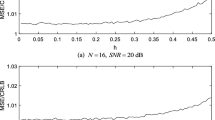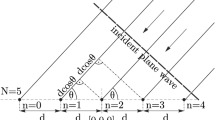Abstract
In this paper, we study the joint design of transmitted sequence and receiving filter to improve the performance of radar in the presence of Doppler shifts. The mean-square error (MSE) of the estimates of the scattering coefficients of the point-like targets is considered to be the figure of merit. The design problem is cast as a joint optimization problem to minimize the MSE in the presence of target and clutter Doppler shifts. To tackle the design problem, we devise a new data model with respect to the Doppler shifts and propose a cyclic iterative approach to obtain optimized pairs for receiving filters and transmitted sequences. The proposed approach is based on fractional programming and iterations of the power method, and this approach is computationally efficient. Moreover, this approach can handle unimodularity constraints, quantization constraints, and peak-to-average power ratio constraints on the transmitted sequence. Simulation examples show the effectiveness of the proposed approach.







Similar content being viewed by others
References
A. Aubry, A. DeMaio, A. Farina et al., Knowledge-aided (potentially cognitive) transmit signal and receive filter design in signal-dependent clutter. IEEE Trans. Aerosp. Electron. Syst. 49(1), 93–117 (2013)
A. Aubry, A. DeMaio, M. Piezzo et al., Cognitive design of the receive filter and transmitted phase code in reverberating environment. IET Radar Sonar Navig. 60(2), 822–833 (2012)
A. DeMaio, S. DeNicola, Y. Huang et al., Design of phase codes for radar performance optimization with a similarity constraint. IEEE Trans. Signal Process. 57(2), 610–621 (2009)
A. DeMaio, Y. Huang, M. Piezzo, The Doppler robust max-min approach to radar code design. IEEE Trans. Signal Process. 58(9), 4943–4947 (2010)
A. DeMaio, Y. Huang, M. Piezzo et al., Design of optimized radar codes with a peak to average power ratio constraint. IEEE Trans. Signal Process. 59(6), 2683–2697 (2011)
W. Dinkelbach, On nonlinear fractional programming. Manag. Sci. 13(7), 492–498 (1967)
S. Haykin, Cognitive radar: a way of the future. IEEE Signal Process. Mag. 23(1), 30–40 (2006)
H. He, P. Stoica, J. Li, Designing unimodular sequence sets with good correlations including an application to MIMO radar. IEEE Trans. Signal Process. 57(11), 4391–4405 (2009)
H. He, P. Stoica, J. Li, Waveform design with stopband and correlation constraints for cognitive radar, in Proceedings of the 2nd Interernational Workshop CIP., pp. 344–349 (2010)
F. Li, Y. Zhao, X. Qiao, A waveform design method for suppressing range sidelobes in desired intervals. Signal Process. 96(3), 203–211 (2014)
M. Naghsh, M. Soltanalian, P. Stoica et al., A doppler robust design of transmit sequence and receive filter in the presence of signal-dependent interference. IEEE Trans. Signal Process. 62(4), 772–785 (2014)
M. Soltanalian, P. Stoica, Computational design of sequences with good correlation properties. IEEE Trans. Signal Process. 60(5), 2180–2193 (2012)
M. Soltanalian, B. Tang, J. Li et al., Joint design of the receive filter and transmit sequence for active sensing. IEEE Signal Process. Lett. 20(5), 423–426 (2013)
M. Soltanalian, P. Stoica, Designing unimodular codes via quadratic optimization. IEEE Trans. Signal Process. 62(5), 1221–1234 (2014)
P. Stoica, H. He, J. Li, New algorithms for designing unimodular sequences with good correlation properties. IEEE Trans. Signal Process. 57(4), 1415–1425 (2009)
P. Stoica, H. He, J. Li, Optimization of the receive filter and transmit sequence for active sensing. IEEE Trans. Signal Process. 60(4), 1730–1740 (2012)
J. Tropp, I. Dhillon, R. Heath et al., Designing structured tight frames via an alternating projection method. IEEE Trans. Inf. Theory 51(1), 188–209 (2005)
G. Wang, Y. Lu, Designing single/multiple sparse frequency waveforms with sidelobe constraint. IET Radar Sonar Navig. 5(1), 32–38 (2011)
X. Zhang, C. Cui, Robust transmitted waveform and received filter design for cognitive radar in the presence of signal-dependent interference. Circuits Syst. Signal Process. 32(6), 3013–3029 (2013)
Acknowledgments
This work was supported in part by the National Natural Science Foundation of China (Grants 61101186 and 61101179).
Author information
Authors and Affiliations
Corresponding author
Rights and permissions
About this article
Cite this article
Wu, H., Song, Z., Fan, H. et al. Joint Design of Transmitted Sequence and Receiving Filter in the Presence of Doppler Shifts. Circuits Syst Signal Process 34, 2621–2641 (2015). https://doi.org/10.1007/s00034-015-9970-2
Received:
Revised:
Accepted:
Published:
Issue Date:
DOI: https://doi.org/10.1007/s00034-015-9970-2




